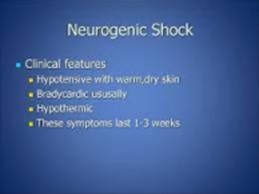A client has sustained a T4-T5 injury and the nurse suspects he is in neurogenic shock. Which of the following manifestations are consistent with neurogenic shock? Select All that Apply
A hypertension
B rapidly elevating temperature
C bradycardia
D fixed and dilated pupils
E hypotension
Correct Answer : C,E
Choice A Rationale: Hypertension is not a sign of neurogenic shock, but rather of autonomic dysreflexia, a life-threatening condition that can occur in patients with spinal cord injury above T6.
Choice B Rationale: Rapidly elevating temperature is also a sign of autonomic dysreflexia, not neurogenic shock. Neurogenic shock can cause hypothermia due to impaired thermoregulation.
Choice C Rationale: Bradycardia is a sign of neurogenic shock due to the loss of sympathetic stimulation to the heart, which normally increases the heart rate and contractility.
Choice D Rationale: Fixed and dilated pupils are a sign of brain death, not neurogenic shock. Neurogenic shock can cause miosis (constriction of the pupils) due to unopposed parasympathetic stimulation.
Choice E Rationale: Hypotension is a sign of neurogenic shock due to the vasodilation and decreased venous return caused by the loss of sympathetic tone.

Nursing Test Bank
Naxlex Comprehensive Predictor Exams
Related Questions
Correct Answer is A
Explanation
Choice A Rationale: Sitting the client at a 90-degree angle (upright position) helps prevent orthostatic hypotension and cardiovascular complications in clients with spinal cord injuries by improving venous return and cardiac output.
Choice B Rationale: Administering 2000 liters of fluid is an inappropriate intervention, and the volume mentioned is excessive.
Choice C Rationale: Applying compression socks may help prevent deep vein thrombosis (DVT) but does not address cardiovascular complications related to sitting position.
Choice D Rationale: Maintaining blood pressure exactly at 110/80 is not a feasible or appropriate intervention.
Correct Answer is C
Explanation
Choice A Rationale: Applying a vest restraint should not be the first action and should only be considered as a last resort after other alternatives have been explored.
Choice B Rationale: Placing the client in bed with two side rails raised may restrict the client's mobility and is not the first choice for managing agitation.
Choice C Rationale: Placing a seat alarm in the client's chair is the first action to take because it allows the nurse to monitor the client's movements and respond promptly to any attempts to get out of the chair while ensuring safety.
Choice D Rationale: Administering lorazepam should not be the first action and should only be considered after non-pharmacological interventions have been attempted
Whether you are a student looking to ace your exams or a practicing nurse seeking to enhance your expertise , our nursing education contents will empower you with the confidence and competence to make a difference in the lives of patients and become a respected leader in the healthcare field.
Visit Naxlex, invest in your future and unlock endless possibilities with our unparalleled nursing education contents today
Report Wrong Answer on the Current Question
Do you disagree with the answer? If yes, what is your expected answer? Explain.
Kindly be descriptive with the issue you are facing.
